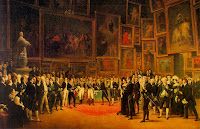 During
my short time in paper bead making, I have found out many interesting things
about these little objects that lead me to believe that they contain a great
deal of meaning. The first time I had heard of these beads was when I traveled
to Goma, an eastern city of The Democratic Republic of the Congo. I visited a
center for children who had undergone a great deal of trauma one way or
another. The center was called The New Hope Center. It was a home for children
who lost their parents to HIV/AIDS, or who witnessed their entire village
slaughtered by rebel armies or other unimaginable things.
During
my short time in paper bead making, I have found out many interesting things
about these little objects that lead me to believe that they contain a great
deal of meaning. The first time I had heard of these beads was when I traveled
to Goma, an eastern city of The Democratic Republic of the Congo. I visited a
center for children who had undergone a great deal of trauma one way or
another. The center was called The New Hope Center. It was a home for children
who lost their parents to HIV/AIDS, or who witnessed their entire village
slaughtered by rebel armies or other unimaginable things.
For
them, making paper bead jewelry was a form of therapy to be able to help them
through the fact that they had been through horrors no one should endure. The
center would then ship the jewelry out to western countries in hopes of selling
them and making money to help pay for these children’s tuition. I then later
saw the beads sold all over Uganda in touristy places. I found out later that
paper bead making is quite popular in Uganda, and is usually connected to
social entrepreneurial programs in hopes to help impoverished women up on their
feet. Other such programs are also located in nations such as Rwanda, Kenya and
South Africa.
I
myself made almost two thousand beads, and I was impressed after such a number
was completed, that women make as many as they possibly can as a living.
However, I realized that in order to make a profit from making paper bead
jewelry, one would have to make thousands of beads daily. The reason for this
is because even though two thousand beads is an impressive number, it really
doesn’t make enough to create the number of necklaces or earrings, which would
be then sold at a nominal price. As someone who is not in the least
professional in bead making, I have only been able to make one hundred beads in
a period of many hours. Although the process of making beads is easy and cheap,
after the five hundredth bead, my fingers would become raw and painful to the
touch, until finally the one-thousandth bead would give the calluses I needed
to carry on.
In
the West, in places like the United States, the United Kingdom and Australia,
beads have begun a renewed interested because of the influx of paper bead jewelry
coming in from Africa. However, due to ignorance, these beads have become
eroticized and are widely considered a quaint item to help shabby clothes
become bright and give an “African” flavor. Ironically the tradition of paper
bead making came from the United Kingdom in the late nineteenth century. Using
fair trade, many stores such as Walmart and Wholefoods have sold this jewelry
advertising them as “you can empower you wardrobe by empowering a woman who
made these beads.” Giving the buyer a sense of good will and charitable giving.
For
me, paper beads walk a fine line between being exploitative or of being full of
meaning. Without the western market to buy paper bead the women in Uganda,
Rwanda, Kenya, ect. would be back to nothing, trying to find another way of
supporting themselves or their families. Paper bead making has become many
things to many people, a way of income, a therapy, or merely just a fun
pastime. I believe, as touchy as they can be, they should remain what they are
right now, a little help to those who need it, until something better might
come along.



































